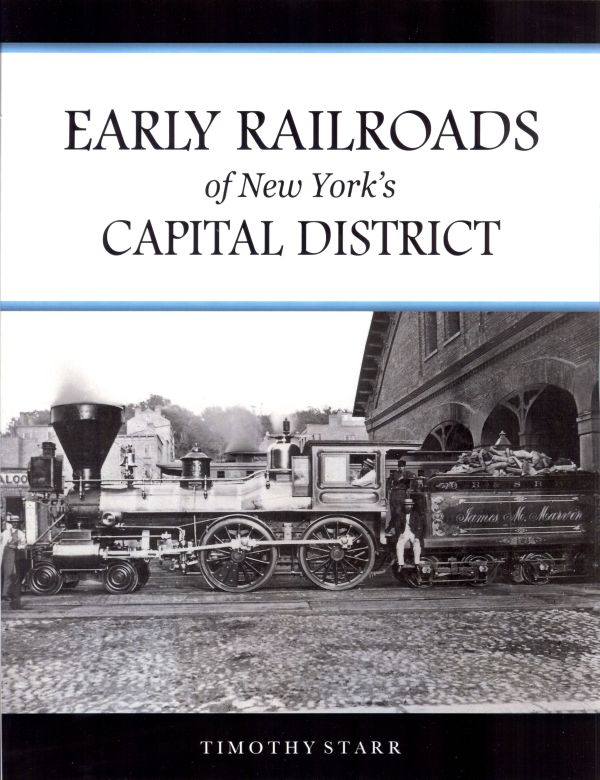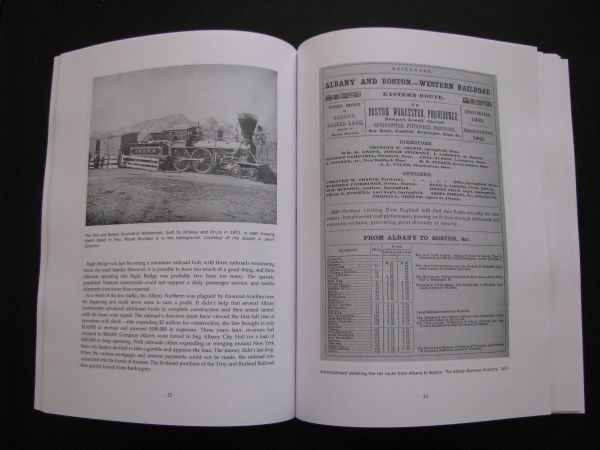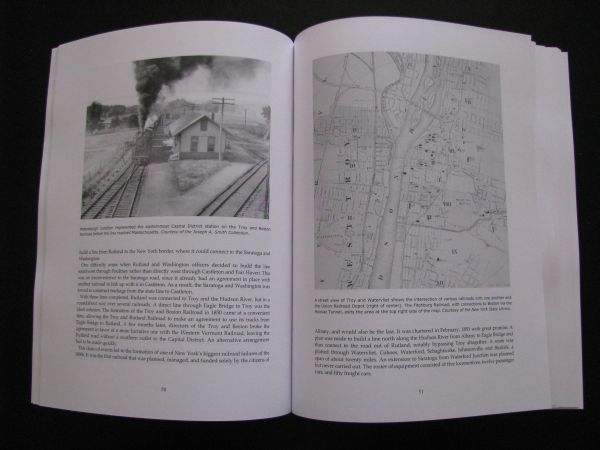|
NEW YORK STATE
A History of its Industries,
Railroads and Inventions

  
|
EARLY RAILROADS
Of New
York’s
Capital
District

|
Early Railroads of New
York's Capital District covers what was perhaps the most exciting
time in railroad history from 1826 to about 1900. The first railroad in
the Capital Region was among the first in the country, and helped
herald in a new age of transportation. After many had been built,
capitalists such as Erastus Corning and Commodore Vanderbilt
consolidated and expanded the railroads until they were part of a
vital national network. The rise of the street railway lines
(trolleys) capped the end of the century.
The book features many
early photographs from the collection of the late
Joseph Smith, provided by his grandson Kenneth Bradford.
Description: paperback
perfect-bound, size 8.5 X 11 inches, 85 black & white photographs and
maps, 125 pages, indexed, appendix
(complete Capital District railroad listing), self-published March
2011, ISBN 978-0-578-08097-0,
Library of Congress Control Number 2011903564. First Edition print
run - 250 copies (as of December 2011, there are still about 75
First Edition copies available).
A companion book was written
at the same time titled "The Golden Age of Railroading in New
York's Capital District" that covers the years 1880 to 1950.
This book was released in January 2012.
|
Table of Contents
|
Introduction |
1 |
|
The Pioneer Railroad |
9 |
|
To The Tourist Mecca |
25 |
|
Gateway to the West |
37 |
|
Connecting to Canada and Boston |
49 |
|
Railroad Wars |
59 |
|
The New York Central |
67 |
|
The Delaware and Hudson |
87 |
|
Into the Wilderness |
97 |
|
Rise of the Street Railway |
105 |
|
|
|
|
Early Railroad Listing |
117 |
|
Bibliography |
120 |
|
Index |
122 |
|
About the Author |
125 |
Excerpt From the
Introduction
Copyright 2010-11 Timothy Starr
New York State was geographically well-suited to become
the leading developer of new transportation networks in
the early 1800s. It lay between the well-settled New
England states and the unsettled west, making it a
gateway through which hundreds of thousands of people
passed on their way to better lives. Vast forests and
mineral reserves convenient to the Hudson River allowed
for industry to develop in the Capital District and
points south. New York harbor served as an important hub
for trade with the outside world and was linked directly
to Albany and Troy. The accumulation of wealth in New
York enabled several important projects to be funded,
most notably the first canals and railroads.
The Mohawk and Hudson
Railroad proved to be profitable from the first, and its success
created a change in public sentiment concerning railroads. The
funding and construction of the Saratoga and Schenectady and the
Utica and Schenectady Railroads were carried out in direct
consequence of the popularity of the Albany road.
These few railroads were
quickly followed by many more as investors wanted to cash in on the
new technology. Forty-nine applications were filed with the New York
State legislature to build railroads in 1832, of which twenty-nine
were granted and six were constructed (Brooklyn and Jamaica; Hudson
and Berkshire; Erie; Rensselaer and Saratoga; the Tonawanda; and the
Watertown and Rome). Within a decade almost every state in the
country had at least one railroad.
The early
railroads of the Capital District were among the most important in
the country. The New York Central, born from the merging of the
first railroads in the state, became the famous “Water Level Route”
that was able to transport goods and people in the most economical
manner to the west. The Delaware and Hudson, running roughly south
to north, became the famous “Bridge Line” to the Adirondacks and
Canada in addition to providing much of New York State with
anthracite coal used in manufacturing. The Boston and Albany became
the primary outlet for the city of Boston, then one of the country’s
most important cities. By the end of the century, these systems were
firmly established and served as vital transportation systems for
the entire nation.

Perhaps the nation's first "union"
station was built in Schenectady
for the Mohawk and Hudson Railroad in 1836 (Efner Collection).

New York Central locomotive
"William H Vanderbilt" outside
of the Delavan House in Albany (Joseph A. Smith collection).



Railroad Book Connects Past to
Present
Published:
March 31, 2011
BY DAN
SABBATINO
A recently
published work about some of the country's first railroads, many of which were
in nearby in the Capital District, is now available at The Brookside Museum.
Timothy Starr wrote “Early Railroads of New York’s Capital District,” published
in March, and it features local history, spanning the years 1826 to 1900.
“Early
Railroads of New York’s Capital District” features 85 vintage photographs and
maps showing scenes throughout the Capital District. Starr said many of the
photographs come from the sizeable collection of Joseph Smith through his
grandson Kenneth Bradford. Others were provided by Ed Bond and local historian
Chris Morley.
"The beginning of the railroad era in
New York State took many by surprise," Starr said. "The Erie Canal had just been
completed a few short months before application was made for the state’s first
railroad. It was considered to be one of the greatest engineering
accomplishments in human history, permitting boats to make the trip from New
York City to the Great Lakes clear across the length of the state for the first
time. Many believed that the state-sponsored marvel would be an unchallenged
transportation system for years to come."
Starr said some forward-thinking
people recognized the shortcomings of the slow and warm weather-dependent canal
system and believed that there was a viable alternative.
In 1826, when only one or two other
railroads existed in the entire country, a charter for a privately-funded steam
railroad was applied for to be built between the Hudson River at Albany and the
Mohawk River at Schenectady. The charter was granted on March 29, and ground was
broken four years later. The first run of the sixteen mile Mohawk and Hudson
Railroad was made in the summer of 1831, witnessed by thousands of awe-stricken
citizens from both cities.
"In an effort to avoid any pretense of
competing with the canal, the first extension of the line was constructed north
to the tourist destinations of Ballston Spa and Saratoga Springs. The Saratoga
and Schenectady was opened in 1832 and enjoyed a thriving passenger trade during
the summer months, sometimes carrying hundreds of people in the primitive coach
cars," he said.
Eventually, railroads were a part of life for those living
in Upstate New York, and according to information from Jon Patton, a railroad
enthusiast who collects first-hand memorabilia relating to 1800s railroads, an
1848 railroad from Sackett's Harbor to Saratoga was a key economic generator.
Starr discusses the history of competing economic
interests, Troy, Albany, Saratoga, and Schenectady and how they all became
connected via railroad. Eventually, other states were accessible too.
|
BOOK INDEX
999
(locomotive), 81, 84
Adirondack Railway, 98-100
Air-brake, 43-45
Albany and Hudson Railway and Power Company, 109-110
Albany and Hudson Railroad, 109
Albany Northern Railroad, 50-52, 54
Albany Railway, 108
Albany and Schenectady Railroad, 23
Albany and Schenectady Turnpike Company, 11, 14
Albany Southern Railroad, 109
Albany and Susquehanna Railroad, 63-65
Albany Union Station, 85
Albany, Vermont and Canada Railroad, 54
Albany and West Stockbridge Railroad, 54
American Locomotive Company, 42
Ballston Terminal Railroad, 111
Boston and Albany Railroad, 54
Boston, Hoosac
Tunnel and Western Railway, 56-57
Boston and Maine Railroad, 57
Brown, William, 18
Cambreling, Churchill, 12, 17
Cattle mart, 74-75
Corning, Erastus, 37, 67-71, 74-76
Davy Crockett
(locomotive), 25
Delaware and Hudson Canal Company, 87-95
Delaware and Hudson Company, 95
DeWitt Clinton
(locomotive), 15, 17, 20
Dickson, Thomas, 87-89
Durant, Thomas, 98-100
Empire State Express, 84
Experiment
(locomotive), 16
Fargo, William, 78
Fast Mail Express
(New York Central), 80-81
Featherstonhaugh, George, 9-12
Firefly
(locomotive), 25
Fisk, James, 63-65
Fitchburg Railroad, 57
Free pass, 20
Gilbert and Eaton, 32-33
Goold, James, 20
Gould, Jay, 63-65
Grant, Ulysses, 101-103
Green Island shops, 90-91
Hoosac Tunnel, 54-56
Hudson River (bridges), 31-32, 47, 76-77
Hudson River Railroad, 59-61
Hudson River Water Power Company, 116
Hudson Valley Railway, 111
Inclined planes (Mohawk and Hudson), 15,
23
Jervis, John, 13, 16-17, 25-27, 30, 60-61
Jervis-type locomotives, 16-17, 23, 26
J.M. Jones’ Sons, 113, 114-116
John Bull
(locomotive), 18
Lake Ontario and Hudson River Railroad, 98
Lansingburgh and Cohoes Railroad, 106
Lightning
(locomotive), 42
Lumber District (Albany), 108
McQueen, Walter, 23
Mohawk and Hudson Railroad Company, 9-23
Mohawk Valley Railroad, 45
Mount McGregor Railroad, 103
New York and Albany Railroad, 59
New York Central and Hudson River Railroad, 79
New York Central Railroad, 67-85, 94
New York and Harlem, 63
New York, West Shore and Buffalo Railway, 83
North Troy and Iron Works Line, 107
Rensselaer and Saratoga Railroad, 31-35,
89
Richmond, Dean, 76-78
Rutland and Washington Railroad, 49-50
Sackets Harbor and Saratoga, 97
Saratoga Electric Railway, 110
Saratoga Limited,
95
Saratoga, Mount McGregor and Lake George Railroad,
101-103
Saratoga Northern Railroad, 103
Saratoga and Schenectady Railroad, 25-31
Saratoga Traction Company, 111
Saratoga and Washington Railroad, 49
Schenectady and Duanesburg Railroad, 90
Schenectady Locomotive Works, 42
Schenectady Railway, 111-112
Schenectady (stations), 39-41
Schenectady Street Railway, 111
Schenectady and Susquehanna Railroad, 90
Schenectady and Troy Railroad, 43-45
Steamboats, 61
Stevens, John, 9
Stillwater and Mechanicville Street Railway, 110
Strike (1877), 81-82
Subway (Schenectady), 29-30
Trolley, 105
Troy and Boston Railroad, 50
Troy City Railway, 112
Troy and Cohoes Railroad, 106
Troy and Greenbush Railroad, 60
Troy and Greenfield Railroad, 56
Troy and Lansingburgh Railroad, 106
Troy and New England Railway, 107
Troy and Rutland Railroad, 50, 52
Troy, Salem and Rutland Railroad, 56
Troy Union Railroad, 34-35, 46-47
Twentieth Century Limited,
84
United Traction Company, 112-114
Union Electric Railway, 110-111
Utica and Schenectady Railroad, 37-39
Vanderbilt, Cornelius, 61-63, 78-82
Vanderbilt, William, 82
Van Rensselaer, Stephen, 9-13
Vibbard, Chauncey, 71-72
Waterford and Cohoes Railroad, 106
Water-Level Route, 82
Watervliet Turnpike and Railroad Company,
108
West Albany shops, 74
Westinghouse, George, 43-45
West Point Foundry, 16
West Shore Railroad, 84
|
|






